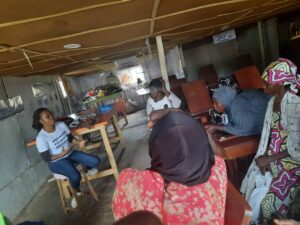Under the Solutions Journalism Africa Initiative, Nigeria Health Watch has assembled and trained the first cohort of Solutions Journalists in the country who are being supported to produce stories.
The participating media organisations are News Agency of Nigeria, Nigeria Info FM, Pulse Nigeria, THISDAY Newspapers, Leadership Newspapers, Daily Trust Newspapers, TalkHealth9ja, Sparkling FM Calabar, Freedom Radio Kano and The Republic.
I asked some of the journalists to share their experience writing solution reports, challenges and advice for interested colleagues.
Below are their responses;
Samson Toromade, Editor (Operations), Pulse Nigeria

Experience
I think what’s been great about working on solution stories is the comprehensive insight you gain on an issue, as opposed to if you were just fishing for only the problem, and not how people are responding to it.
In writing my stories, I compiled a list of common health problems and started looking around for individuals and organisations doing something to address those problems in their own capacity, and how their initiatives have been working.
Challenges
The challenges of writing solution stories aren’t much different from what you get from regular stories. What’s usually most important is getting the most relevant subjects to provide you with all the necessary information you need; and that can be difficult sometimes, for varying reasons. I kept trying to talk to a subject and he kept postponing for like three weeks, I had to evolve my story angle to remove him and find some other equally important subject.
Impact
I wouldn’t like to compare with other types of content yet, but I’ve found that for both stories I’ve done, the solutions advocate have been welcoming of the spotlight put on their response, and how to maximise the attention to get more people to contribute to their cause.
Story by Toromade Drug aid saving underprivileged from Nigeria’s healthcare
Ismail Abdulaziz, Assistant-Editor-In- Chief, News Agency of Nigeria

Experience and lessons learnt
Quite a few improvements were achieved in these six months of my Solutions Journalism project. The first was that of doing the same thing as a journalist and editor but in different ways.
Writing the stories from whole rather than few narratives. I have gone from writing stories about woes to writing about what is being done about the woes. That was a great milestone.
Getting the right sources was also another experience. Unlike the usual stories that are rushed to press, SoJo stories required a more accurate and targeted search for the appropriate sources, data and events and then writing a whole picture from different angles.
I working knowledge of multimedia is also a good talent to have when engaged in SoJo stories because you may need to add pictures and videos in the stories.
Challenges and advice for colleagues
One of the challenges was finding time to slow down and get yourself out of the breaking news syndrome. It takes time but the joy of writing Solutions Journalism stories made me conquer that syndrome.
I advise colleagues interested in writing SoJo stories to have an open mind to learn new ways of story writing. It’s not as if it is something new, but having the patience to learn something new with its rules and system (the SoJo stories four pillars).
Story by Abdulaziz
Collaborating to provide safe drinking water in Sauka Community, FCT
Chika Mefor- Nwachukwu, freelance journalist

Experience in writing Solution Journalism Stories
The first time I heard about Solution Journalism, I decided to read more about it. I then noticed that some stories I have done in the past, were ‘somehow’ Solution-based but lacked some basic elements; I clearly stated the response to a particular social problem but didn’t dig deep to know why the response was having such a positive impact.
I came to realize that my stories must identify the root causes of a social problem; prominently highlight a response, or responses, to that problem; present evidence of the impact of that response; and explain how and why the response is working, or not working.
I fully embraced this type of journalism because I was exhausted from writing about the ‘many problems with no solutions in sight. Now, I have a space to write about the solution and responses to the social problems in the country.
Challenges and advice for colleagues
My challenge while pursuing my story was not how to get this evidence but how to quantify them. In some of the stories I encountered, there were surely responses that brought about positive impact to the problems but how to quantify these impacts become a challenge.
Another challenge I encountered, was getting my sources to speak to me. In the last story I did, I nearly gave up but persisted, and finally, I was able to finish up the story.
Another challenge is the danger of not getting our information right. Sometimes, when your sources see you are interested in what they are doing, they tend to exaggerate. That is why it is important to have multiple sources to verify our information.
Apart from the above, I will advise journalists interested in Solution Journalism to read up about it. I knew nothing about this type of journalism the first time I came across it. I just began to do my research and that helped me a great deal. I am still learning, though because I feel there is a lot to learn.
They should also be alert and register for training on Solution Journalism to gain more knowledge on this type of journalism.
Story by Mefor-Nwachukwu
Delivering babies in a Nigerian camp: ‘I’ve had to use plastic bags as gloves’






